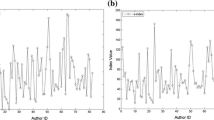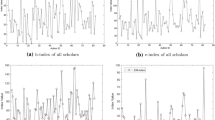Abstract
In the research community, generally the assessment of scholarly impact of an individual is based on citation counts of publications. Instead of this a different approach, year based h-indices have been developed based on different parameters such as total number of publications in year, total citation count earned by all the publications published in a particular year and the total number of citations earned in a particular year by all the publications which are published in any year. This index used the concept of original h-index to determine the index value. But the h-index suffers with big hit problems and the year based indices do not account the h-index big hit problems. To overcome this limitation of year based indices, we have extend the year based h-index with the EM-index and have defined a new approach named year based EM-index with three variants, which are year based EM-index by publications, publication year citations count and citation year citations. This year based EM-index considers only the h-core articles for scientific evaluation, but all those year based indices do not consider all items which have been occurring at least one time. To overcome this limitation of year based EM-index, we have extended the year based EM-index with \(\hbox {EM}^{'}\)-index and have defined year based \(\hbox {EM}^{'}\)-index, that consider all the items which occur at least one time. To legitimate the proposed method, an experimental study has been made on 89 scientists publication data, who are working in scientiometrics and bibliometrics fields. The experimental results show the capabilities of the year based EM-index and \(\hbox {EM}^{'}\)-index over the year based h-indices.





Similar content being viewed by others
Change history
26 July 2018
In the original publication, Acknowledgements was published with incomplete information. The complete Acknowledgements is given in this correction.
References
Alonso, S., Cabrerizo, F. J., Herrera-Viedma, E., & Herrera, F. (2009). h-index: A review focused in its variants, computation and standardization for different scientific fields. Journal of Informetrics, 3(4), 273–289.
Bihari, A., & Tripathi, S. (2017). Em-index: A new measure to evaluate the scientific impact of scientists. Scientometrics, 112(1), 659–677.
Bornmann, L., & Daniel, H.-D. (2007a). Convergent validation of peer review decisions using the h index: Extent of and reasons for type I and type II errors. Journal of Informetrics, 1(3), 204–213.
Bornmann, L., & Daniel, H.-D. (2007b). What do we know about the h index? Journal of the American Society for Information Science and Technology, 58(9), 1381–1385.
Bornmann, L., Mutz, R., & Daniel, H.-D. (2008). Are there better indices for evaluation purposes than the h index? A comparison of nine different variants of the h index using data from biomedicine. Journal of the American Society for Information Science and Technology, 59(5), 830–837.
Costas, R., & Bordons, M. (2007). The h-index: Advantages, limitations and its relation with other bibliometric indicators at the micro level. Journal of Informetrics, 1(3), 193–203.
Egghe, L. (2006a). An improvement of the h-index: The g-index. ISSI Newsletter, 2(1), 8–9.
Egghe, L. (2006b). Theory and practise of the g-index. Scientometrics, 69(1), 131–152.
García-Pérez, M. (2009). A multidimensional extension to Hirschs h-index. Scientometrics, 81(3), 779–785.
Hirsch, J. E. (2005). An index to quantify an individual’s scientific research output. Proceedings of the National Academy of Sciences of the United States of America, 102, 16569–16572.
Jin, B., Liang, L., Rousseau, R., & Egghe, L. (2007). The r-and ar-indices: Complementing the h-index. Chinese Science Bulletin, 52(6), 855–863.
Maabreh, M., & Alsmadi, I. M. (2012). A survey of impact and citation indices: Limitations and issues. International Journal of Advanced Science and Technology, 40, 35–53.
Mahbuba, D., & Rousseau, R. (2013). Year-based h-type indicators. Scientometrics, 96(3), 785–797.
Mahbuba, D., & Rousseau, R. (2016). New definitions and applications of year-based h-indices. COLLNET Journal of Scientometrics and Information Management, 10(2), 321–332.
Rosenberg, M. S. (2014). A biologists guide to impact factors. Technical report, PeerJ PrePrints.
Rousseau, R. (2006). New developments related to the Hirsch index.
Rousseau, R., & Leuven, K. (2008). Reflections on recent developments of the h-index and h-type indices. COLLNET Journal of Scientometrics and Information Management, 2(1), 1–8.
Todeschini, R. (2011). The j-index: A new bibliometric index and multivariate comparisons between other common indices. Scientometrics, 87(3), 621–639.
Todeschini, R., & Baccini, A. (2016). Handbook of bibliometric indicators: Quantitative tools for studying and evaluating research. New York: Wiley.
Wildgaard, L., Schneider, J. W., & Larsen, B. (2014). A review of the characteristics of 108 author-level bibliometric indicators. Scientometrics, 101(1), 125–158.
Zhang, C.-T. (2009). The e-index, complementing the h-index for excess citations. PLoS ONE, 4(5), e5429.
Acknowledgements
The authors wish to express their gratitude to anonymous reviewers for their valuable comments.
Author information
Authors and Affiliations
Corresponding author
Rights and permissions
About this article
Cite this article
Bihari, A., Tripathi, S. Year based EM-index: a new approach to evaluate the scientific impact of scholars. Scientometrics 114, 1175–1205 (2018). https://doi.org/10.1007/s11192-017-2625-2
Received:
Published:
Issue Date:
DOI: https://doi.org/10.1007/s11192-017-2625-2




